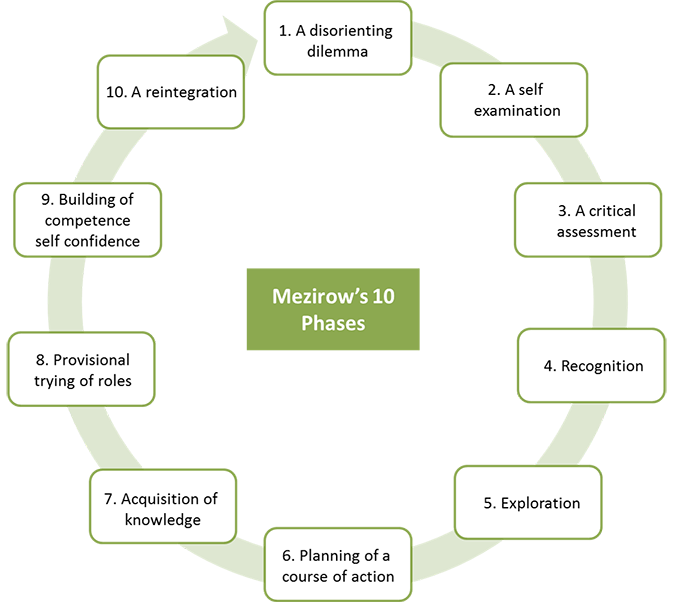Leveraging the Power of Transformative Learning in eLearning

As a training manager, there will always be one question on your minds – “How do I train my learners in a better way?” And the fact that they are not just mere learners, but ‘adult’ learners makes it even harder to find the right way to train them. No one can explain the way adult learners learn better than Malcolm Knowles. According to him, adults learn when:
- They know why they should learn
- They need solutions or workarounds to current challenges
- Learning is task-oriented
- Learning is linked to prior knowledge
There are many theories linked to adult learning, with the aim to make the entire learning journey effective. One such theory is the ‘Theory of Transformative Learning’ by Jack Mezirow.
What is Transformative Learning?
Mezirow describes transformational learning as being “constructivist, an orientation which holds that the way learners interpret and reinterpret their sense experience is, central to making meaning and hence learning.” Basically, it is learning that causes a shift in the perspective of an individual. It involves the designing of learning content that brings a change in the way learners perceive things, leading to acquiring new information.
How does effective learning occur in transformational learning?
- Identification of the crisis
- Establishment of relevance
- Critical reflection
How Does Effective Learning Occur in Transformational Learning?
According to Mezirow, transformational learning takes place in 10 phases.

Source: www.researchgate.net
Keeping these phases in mind, ATD talks about three stages of learning in the transformational learning theory.
1. Identification of the crisis
This is the initial stage of transformational learning which includes the learners realizing that the beliefs they’ve been depending on all this while are no longer viable. Once they realize they’ve been holding on to the wrong beliefs, they will try to search for information that is right. This can be done by pointing what they do not know, thus making them curious to find out more.
2. Establishment of relevance
As mentioned in the beginning of this blog, adults learn when they know why they should learn. They need to know what’s in it for them if they take up the learning. They need to be sure the efforts they invest in learning will bear fruits at the end of the learning process. This can be done by letting them know in the very beginning of the learning as to what exactly they will be achieving if they take up that training.
3. Critical reflection
The process of critical thinking involves three steps:
- Critically question one’s own beliefs
- Being open to alternative beliefs and critically reflecting on the newly perceived information
- Making a personal judgement based on the newly acquired information
Once you let your learners sort through their beliefs and realize that they indeed were wrong all this while, the chances of them accepting learning increases.
How can eLearning provide a transformational learning experience?
- Provides a platform to gain direct experience
- Enables critical reflection
- Encourages collaboration
How Can eLearning Provide a Transformational Learning Experience?
Provides a platform to gain direct experience
In a research on Transformative learning, Taylor (2007) found out that offering direct and active experiences that are meaningful to learners is one of the best ways to foster transformative learning. Providing a direct experience is all about giving learners the chance to perform an action in a safe environment before they move on to performing the task in real life.
So how does eLearning offer a direct experience to learners?
In eLearning, this can be done by incorporating simulations. Simulations provide learners a safe platform, similar to the real platform, which allows them to perform various actions without the fear of failure. For example, let’s imagine you are planning to train surgeons on a surgical procedure using simulations. This will allow the learners to gain direct experience in a real-life setting where they can select surgical tools and perform the surgery. Thus, this provides learners a platform where they can practice without the fear of making a mistake or failing, before going out and performing an actual surgery.
Merely listening to a lecture, watching a video, or reading a chunk of text from a PDF will not lead to transformative learning. It is when a platform to gain enough experience and put the newly acquired knowledge into action before actually performing the task in the workplace is provided that a shift in learners’ perspective can be observed.
Enables critical reflection
As mentioned earlier, the process of critical reflection is all about critically questioning one’s own beliefs, being open to looking at alternate point of views, and eventually making a final judgement based on the newly acquired information.
So how does eLearning enable learners to critically reflect on their pre-assumed beliefs?
One of the main ways this happens is through the integration of discussion forums within the Learning Management System. Discussion forums are platforms in which either the instructor or learners pose questions and others can post their opinions. Once a mentor poses an open-ended question to learners, they will automatically question their beliefs and look up for new information to answer it. Thus, realization and transformation take place.
Besides discussion forums, critical reflection can be enabled by posing open-ended, thought-provoking questions right at the beginning of the course too – a question that will challenge their beliefs. This will also motivate learners to go on further into the course and find out what’s right.
Another way eLearning enables critical reflection is through incorporating scenarios. Scenario-based learning puts learners in situations similar to what they will face in their workplace and assess how they would respond/act. Learners will have to critically analyze the situation, draw on what they’ve learned, and respond appropriately.
For example, consider a scenario on the importance of strong passwords for systems. Learners can be given a scenario where the character uses a password known to his colleagues (his pet’s name followed by his birthday), and very easy to guess. Definitely not something to be practiced, right? Learners will then have to reflect on what they have learned in the course and frame a strong password.
Encourages collaboration
How do most of our beliefs change? In this world of constant communication, it is when we have conversations with others who have an alternative belief. During this process, our beliefs are challenged, and we become open to the other person’s belief, gradually altering our own. Mezirow cannot agree more with this.
Discourse with another is an essential element of transformative learning. (Mezirow, 1991) Yes, participating in a discussion with another individual can foster transformative learning. In fact, Joyce Henderson, a professor at the University of Maryland in her study on transformative learning states that an online environment is more beneficial since learners can put in their views or post their opinions without getting interrupted by others. Also, learners who are comfortable speaking online will be engaged throughout the learning.
Collaboration in eLearning is not just restricted to discussion forums. Besides discussion forums, there are many other tools such as:
- Whiteboards: A collaborative tool through which the instructor can present information and learners are invited to view and contribute.
- Chat and instant messaging: An informal collaborative tool that facilitates real-time discussions that are spontaneous.
- Polls: A tool that provides learners with a platform to voice their opinions by choosing their responses from those provided.
Transformative learning is often pushed away from the limelight stating that genuine transformation is hard to achieve. But with eLearning, this is not the case. Various statistics prove that eLearning increases retention rates by 25-60% and also boosts workplace productivity by 50% which proves that transformation indeed happens.





